If you asked me my favourite memories from Colombia I would say the fruit juices at the market and drinking aguardiente with Colombian friends at Tin Tin Deo salsa bar in Cali. I know both these involve drinks in Colombia, but hey at least one of them is non-alcoholic!
When I was in Colombia I was a bit burnt out.
I didn’t write a lot when I was there but I had such an amazing time during the 3 months that I wished I could overstay my visa.
Fun fact, I actually did overstay one day by mistake but the border control said nothing as I traveled onto Ecuador.
PLANNING A TRIP TO COLOMBIA?
30 Colombian Foods You Don’t Want to Miss
Colombian Slang Survival Guide
Best Museums in Bogota
My Favourite Colombia Hostels
Yet, I’ve always felt like I didn’t do the country justice. It’s one of my favourites and yet I didn’t share much.
So I wanted to share my favourite Colombian drinks – because no one should visit Colombia without looking for these.
Drinks in Colombia to Savour
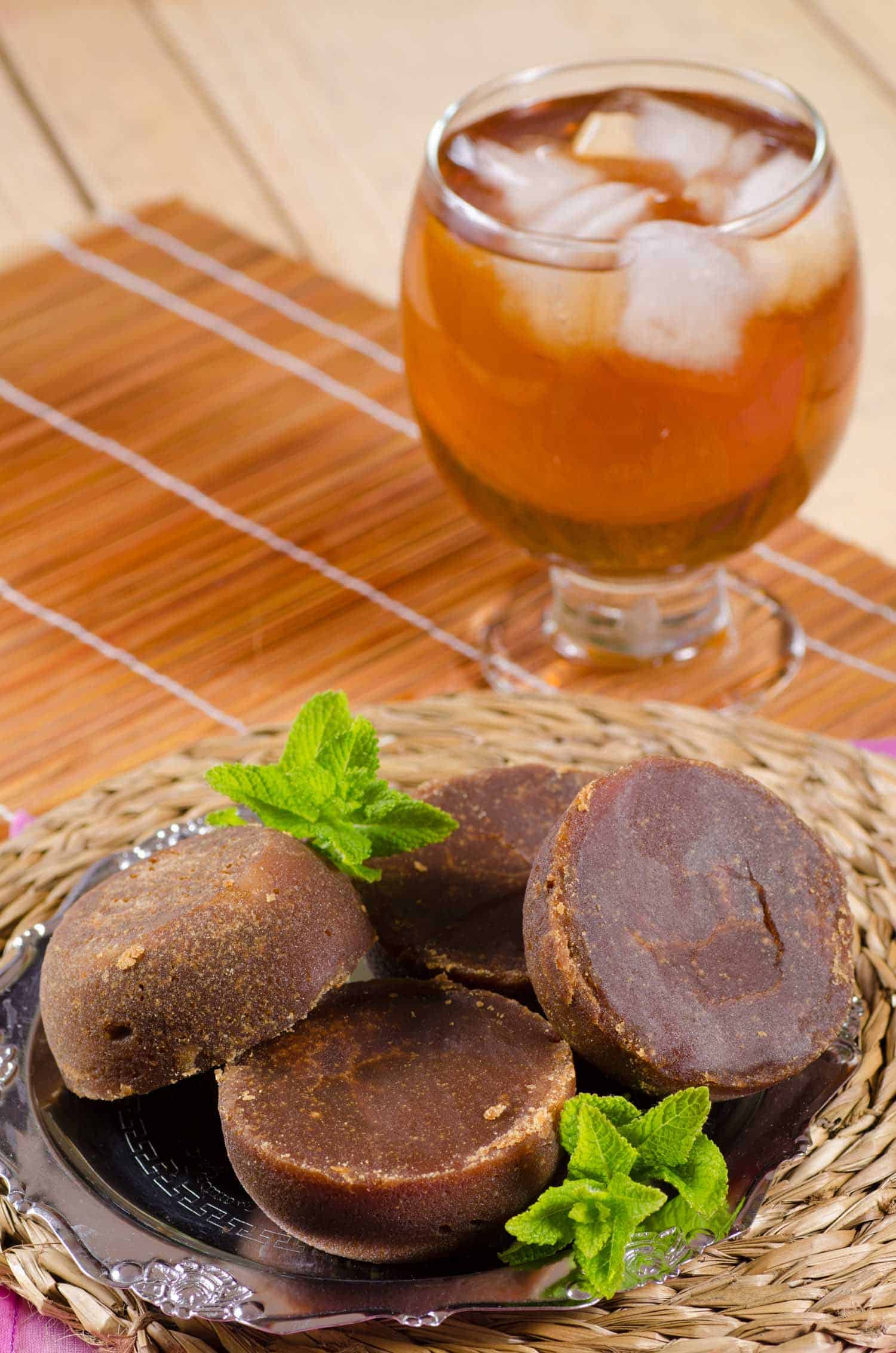
There are a number of alcoholic drinks in Colombia that I enjoyed – at times too much.
However, Colombia isn’t just about drinking and partying.
There are lots of interesting non-alcoholic drinks in Colombia that come from the indigenous people but continue to be popular today.
Not all of them sound 100% appetizing but they are all worth trying – even if they have chunks of food in them!
Colombian Street Food
Aguapanela
Panela is unrefined sugar cane water. And agua is water. So agua de panela OR aguapanela is basically sugar cane water.
This is one of the most traditional drinks in Colombia and it’s not surprising. With sugar cane fields in Colombia, this would have been one of the cheapest and readily available drinks.
Today it is still popular as Colombians keep panela in their home and simply mix it with hot water.
It can be served hot or cold.
Translates to “panela water” and is a traditional and popular Colombian drink, which can be served hot or cold.
Colombian Breakfast Foods
Aguapanela is agua mixed with panela, unrefined cane sugar.
While it’s found everywhere, it’s often given as a remedy for sickness and low energy. Obviously the sugar high would make people feel a little bit better.
Colombians often make this drink for breakfast and may also add lime or spices like clove and cinnamon.
In Bogota cafes it may also have milk and served with a piece of cheese.
The traditional way to eat it is to put the cheese in the agua de panela and let it melt a bit then spoon it out like soup.
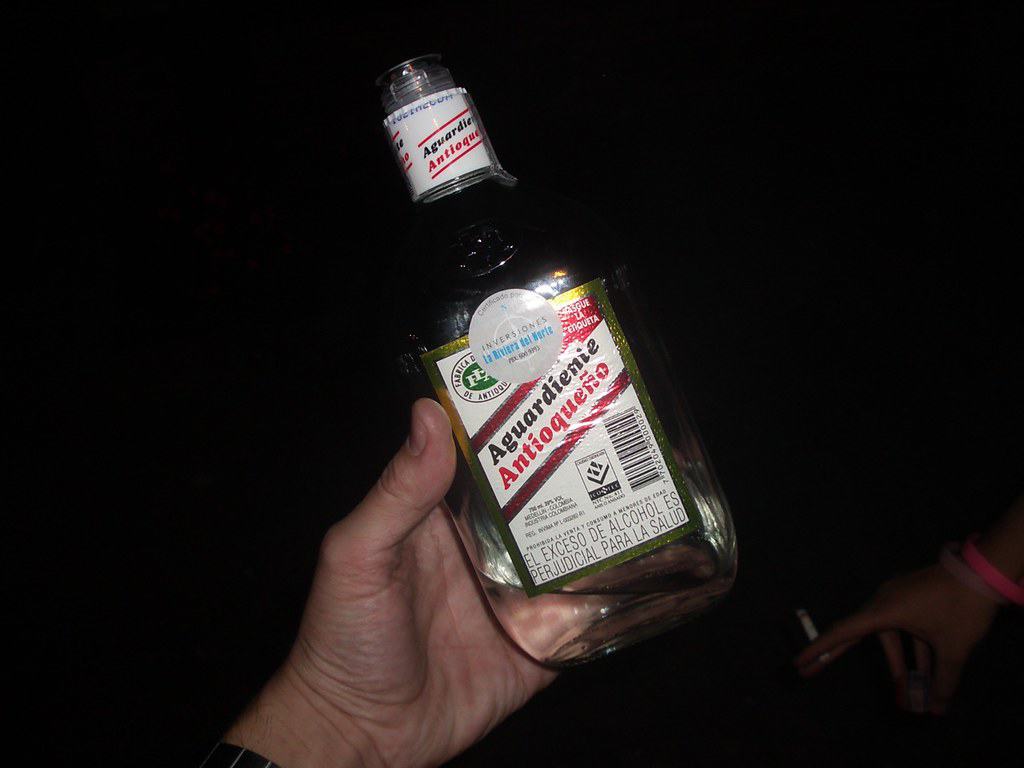
Aguardiente
If you like to try local spirits the first thing you need is this national liquor of Colombia that translates as fire water.
It is clear sugar cane alcohol. You may have tried it as guaro in Costa Rica and it’s one of the most popular Honduran drinks.
It’s also similar to cachaça in Brazil, which is also made from sugarcane. But it’s not quite the same. Aguardiente is much closer to rum.
Commercial brands, like the popular Antioqueño are usually about 29% alcohol but tastes like it’s stronger.
It is most often an anise flavour but you can also find lots of other flavours too.
In Ecuador I often bought a lime aguardiente which made it feel less harsh.
When you’re out drinking with friends it’s most common to buy a bottle of aguardiente for the table. It is served in the centre with a pitcher of water and small cups and you basically shoot it.
Not all aguardiente is harsh but most are. I don’t savour the flavour.
Avena (Colombiana)
While an oatmeal shake doesn’t sound immediately appealing this is one of the most traditional drinks in Colombia.
And for good reason. It’s healthy and very hearty.
Oats are heated with milk, water, sugar, cinnamon and cloves. After reaching a boil it simmers for 20 minutes and then is cooled in the fridge.
Finally it is strained and ready as a drink.
A great thing about this Colombian drink is that it is easily vegan by substituting almond milk.
Canelazo
Canelazo may be one of my all-time favourite warm drinks.
I first tried it in Ecuador in a remote village I had traveled to for an indigenous festival.
It was higher up in the Andes but at night there were tons of vendors out selling warm canelazo to keep the festivities going.
I was so excited to see this drink in Colombia as it’s almost like a warm cider or a hot toddy…although it’s alcoholic so it packs a punch.
It’s a simple recipe of aguardiente heated with agua de panela, lime juice, cinnamon and clove. Some vendors also like to throw in fruit to add a bit more flavour.
It’s definitely a cooler weather drink. Most people are surprised Colombia can be cold, but again don’t forget those mountains.
In the winter it can be jeans and heavy sweater weather. I could never pass up a warm canelazo on these evenings.
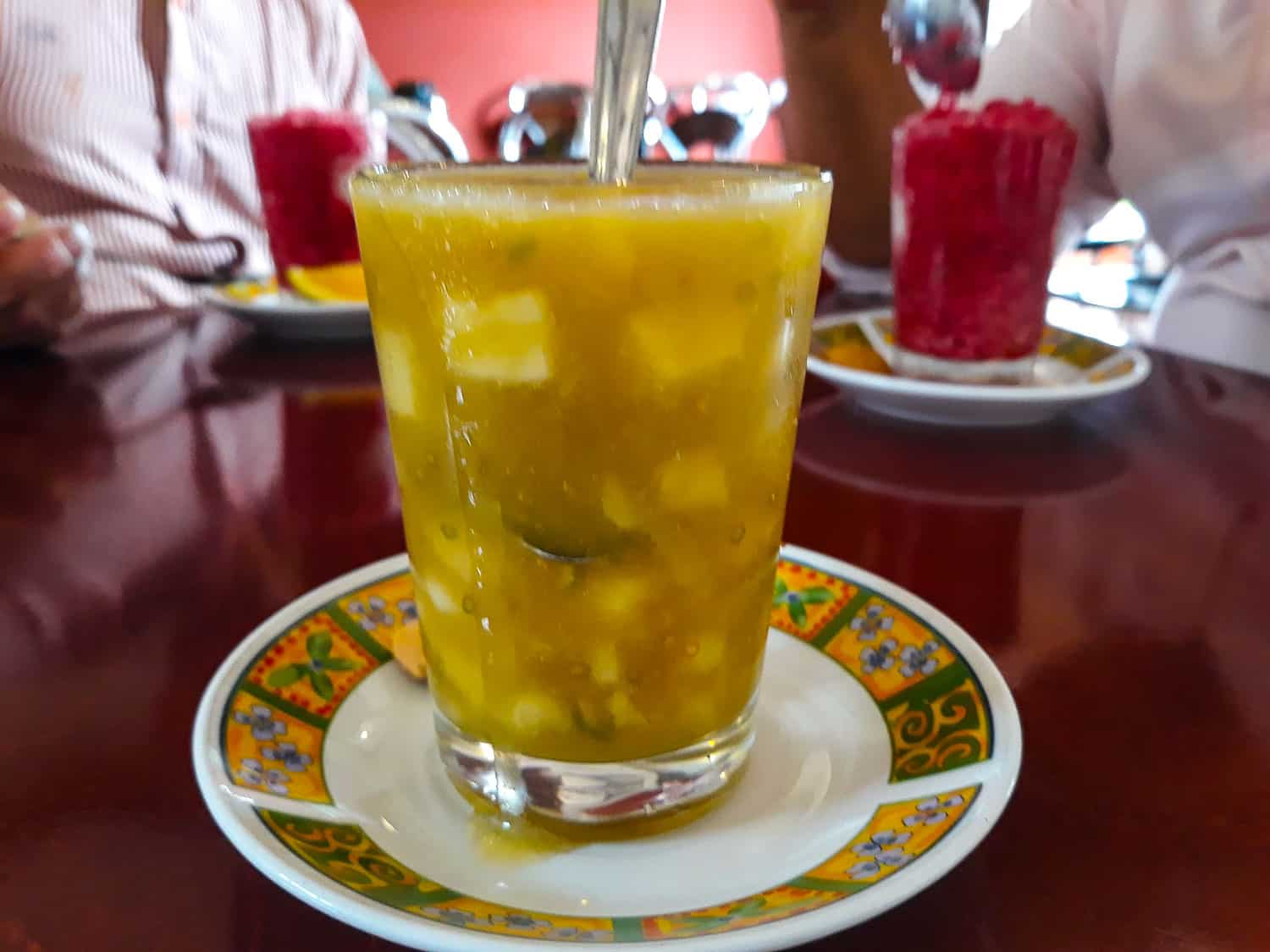
Champús
Yes the name of this Colombian drink is pronounced like shampoo.
But I swear it tastes nothing like it, the name comes from Quechua chapusca and means mixture.
It is very common during Christmas in Colombia. Champús is a mixture of dried corn, pineapple, lulo (also called naranjilla) and panela, with cinnamon, cloves and orange leaves.
It is very common in Cali and its surrounding region. You’ll find people selling it on every corner.
Chapil
One of the drinks in Colombia that may be more difficult to find unless you are visiting the Nariño region that borders Ecuador and the Pacific Ocean.
A type of aguardiente made by the Awá indigenous people (also known as Kwaiker or Awa-Kwaiker).
They believe this drink scares the evil spirits and invites the good spirits.
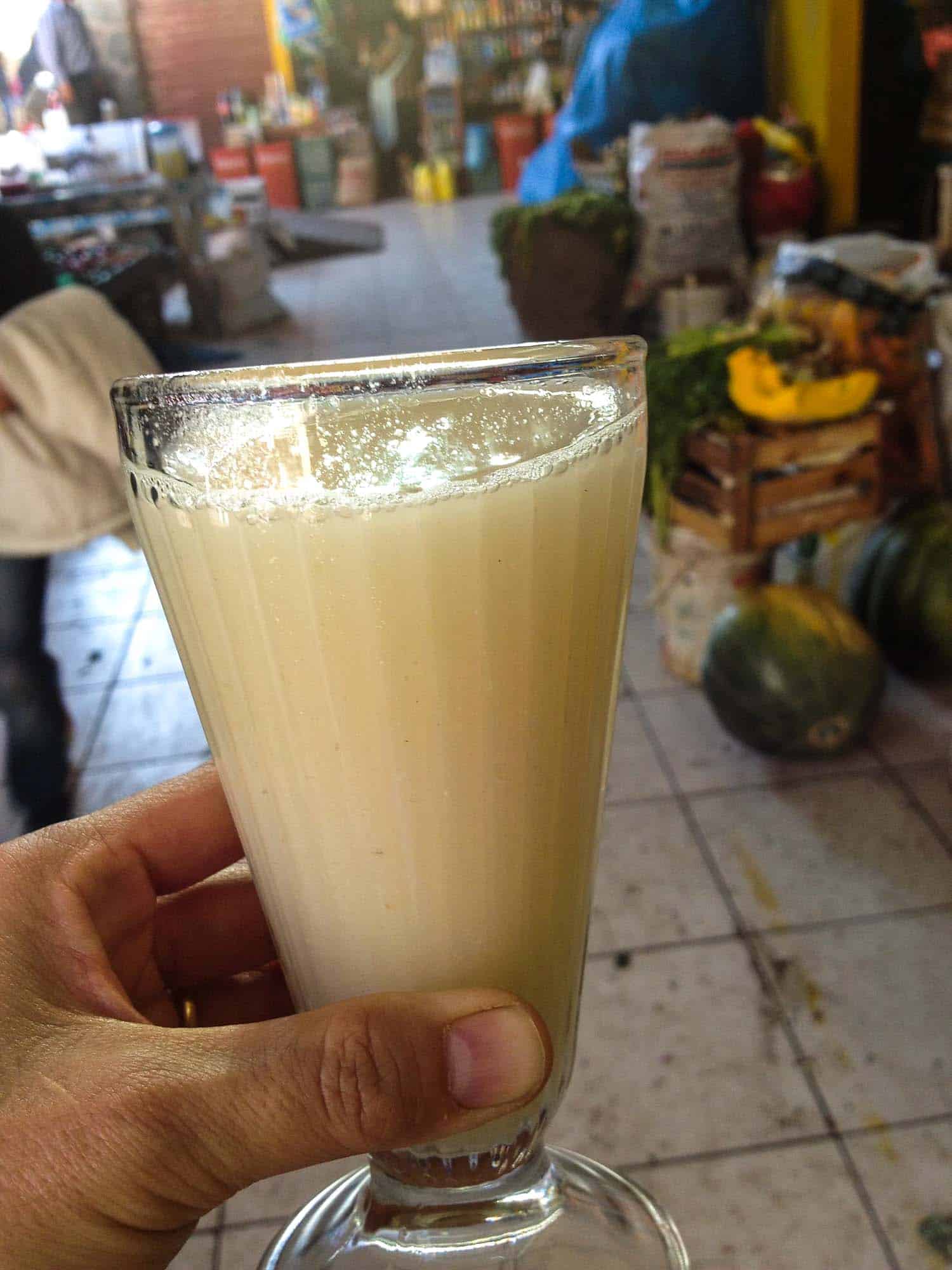
Chicha
You can find this corn drink in many South American countries. It is a traditional indigenous drink common in the Andes that dates back to pre-Columbian times.
In Peru they have a vibrant chicha morada made from purple corn.
It’s a bit frothy and even a bit creamy. If you try chicha once and don’t like it, try it again somewhere else.
There are so many variations of chicha recipes that vary from town to town or even family to family.
At its most basic is this Colombian drink made with fermented corn and panela and pineapple – similar to many drinks in Mexico.
But it’s rare to see such a simple recipe. Sometimes you will find it sweetened with sugar or honey. It’s also possible to have it with potatoes, rice, quinoa or yuca.
Before the Spanish invaded and introduced beer and aguardiente, chicha was the most common alcoholic drink.
Ecuadorian Drinks
It’s actually a fascinating story of how the Spanish worked hard to get rid of chicha with a lot of racist propaganda against the indigenous population – you can read about it here.
Chicha is technically illegal. But the antiquated law is never enforced.
Today you’re more likely to see it in small towns in the Andes but it seems to be making a come back.
If you’re keen to try it head to the market or ask around for the best chichero.
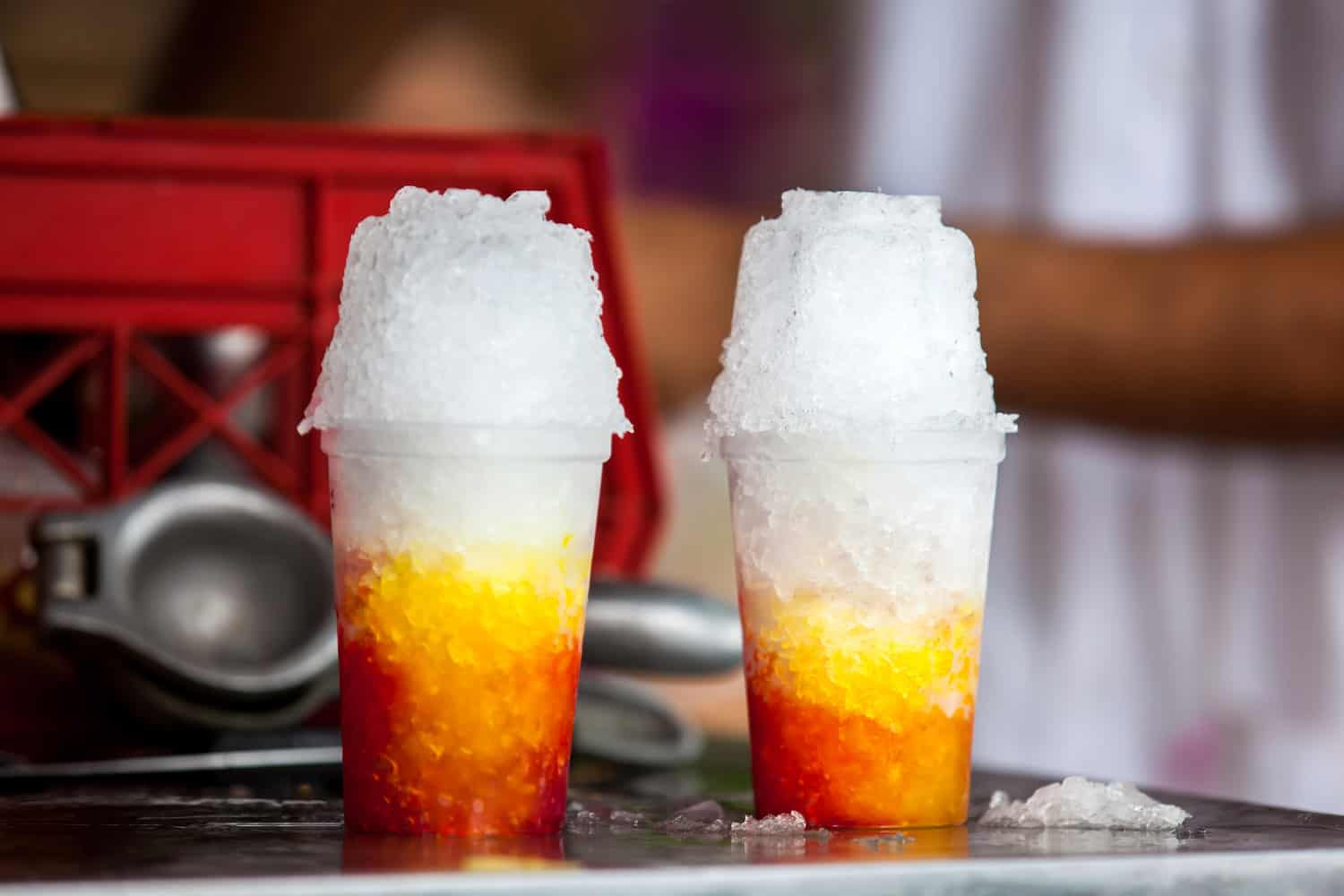
Cholado
I’m a bit biased when it comes to different regions in Colombia because I spent so much time in Cali.
It’s considered the salsa capital of the world and I love any city near the ocean.
However, Cali really does have the best drinks in Colombia. There are just SO many of them. And they are all so good.
I first had a cholado long before I had instagram but I’m not surprised people are posting so many photos of these colourful drinks.
Think snow cone meets fruit cocktail and you’ll get flavoured ice that can be topped with fruit, coconut flakes and sometimes condensed milk.
It is very similar to the raspado in Panama.
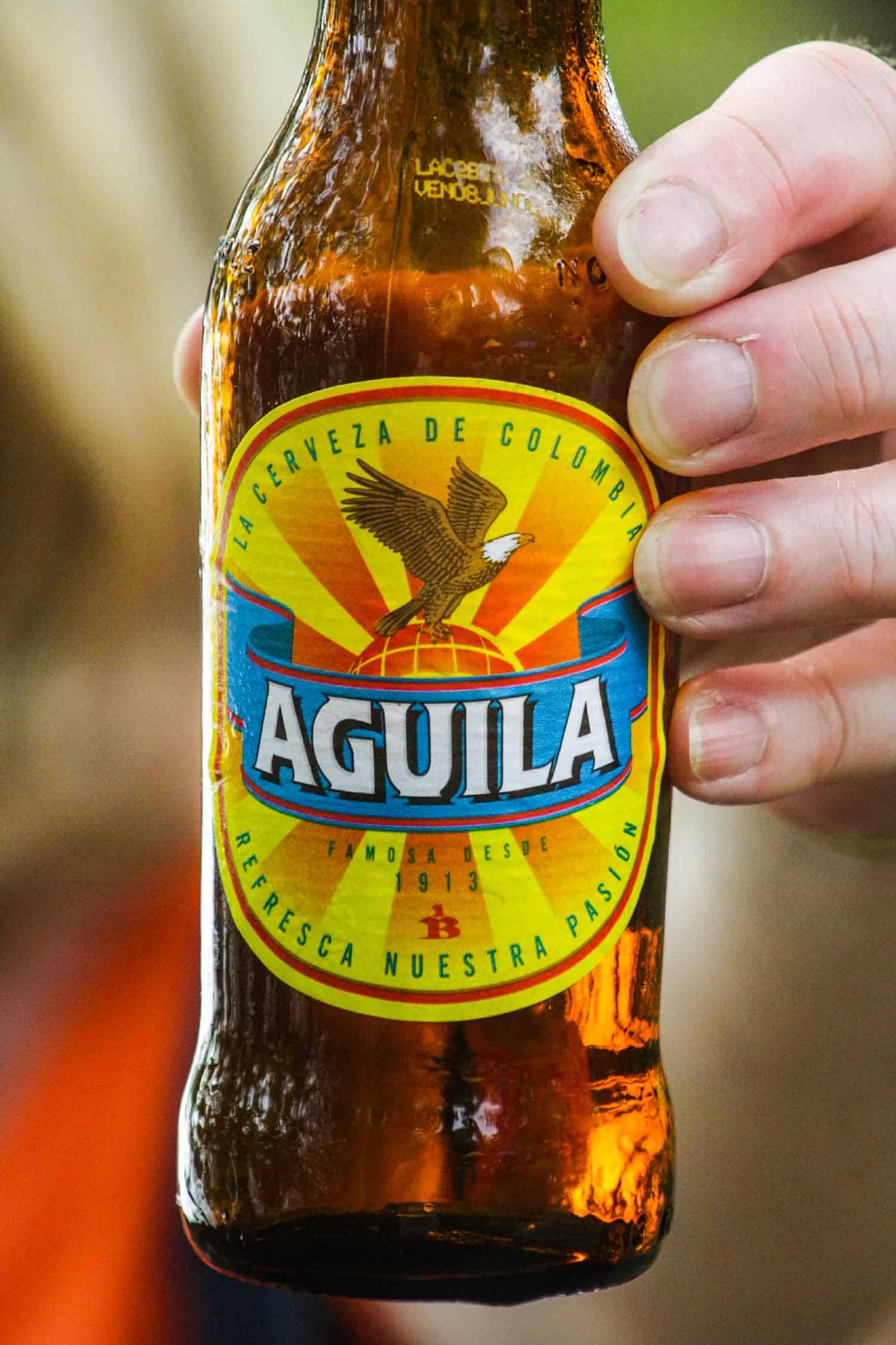
Colombian Beer
If you’ve traveled anywhere in Latin America you know the beer is….ahhh….ok
There is usually some kind of lager and many watered down beers – which is good for me because that’s exactly what I like.
Colombia is slightly different because colonizing Europeans tried to vanquish chicha for their own profits and so the German Bavaria empire opened a factory back in 1889. It eventually became the second largest brewery in South America.
Although manufacturing for Latinx tastes, mostly of watery lagers – yay for me.
Today beer is known as birra (beer-ah), chela (che-la) or pola (poe-la) and there are many national beers, including:
- Águila
- Club Colombia
- Costeña
- Pilsen
- Poker
Would you believe Bavaria currently controls 98% of the beer market in Colombia. Thankfully, like everywhere else small cervecerías have become hot in cities like Bogota and Medellin where you can find craft beer makers:
- Apostol (Bogota)
- Bogotá Beer Company aka BBC (Bogota)
- Chelarte (Bogota)
- Colón (Bogota)
- Gigante (Bogota)
- Happy Jaguar (near Minca)
- La Pola Cervecería (Bogota)
- RagnaröK (Bogota)
- Serpens (Bogota suburb of Fontibón)
- Tres Cordilleras (Medellin)
- 3 Cárites (Bogota)
As all of the national Colombian beers are owned by multinationals I think it’s important to support the local craft breweries.
Coffee
Coffee is without a double one of the most popular drinks in Colombia. But, would you believe that the best coffee in the world is not in Colombia?
Controversial I know. But hear me out:
Colombian certainly makes some of the best coffee in the world. In fact there are well over half a million coffee farms. And they only grow Arabica beans. But the highest quality Colombian coffee is usually exported.
Cuban coffee consumed in Cuba is “stretched” by adding a legume called chicharo.
It is completely legal to do this in Cuba and I heard it is also stretched in Colombia for local consumption.
In fact, most of the time I was offered Nescafe and was told the joke that it should be no es cafe which translates as it’s not coffee.
Most often coffee like this is called tinto because of its reddish hue (red wine is called tinto). It is the cheapest coffee.
It uses the cheapest beans or is freeze dried instant coffee so it’s not called cafe.
You’ll see people drinking them in small cups and adding tons of sugar to mask the poor taste.
A tinto campesino which is filtered coffee with panela (raw sugar cane) as the sweetener.
Honestly it’s not that bad if it’s fresh. It’s certainly a local experience.
At one time the most prolific coffee shop were the mass chains Juan Valdez Cafe and Oma. But Colombia is changing and new coffee shops are opening up in cities.
It costs more than tinto but you can find the best coffee in Colombia served in a variety of ways from espresso to pour overs.
CHECK OUT>> Best Independent Cafes in Bogota
A tinto campesino which is filtered coffee with panela (raw sugar cane) as the sweetener.
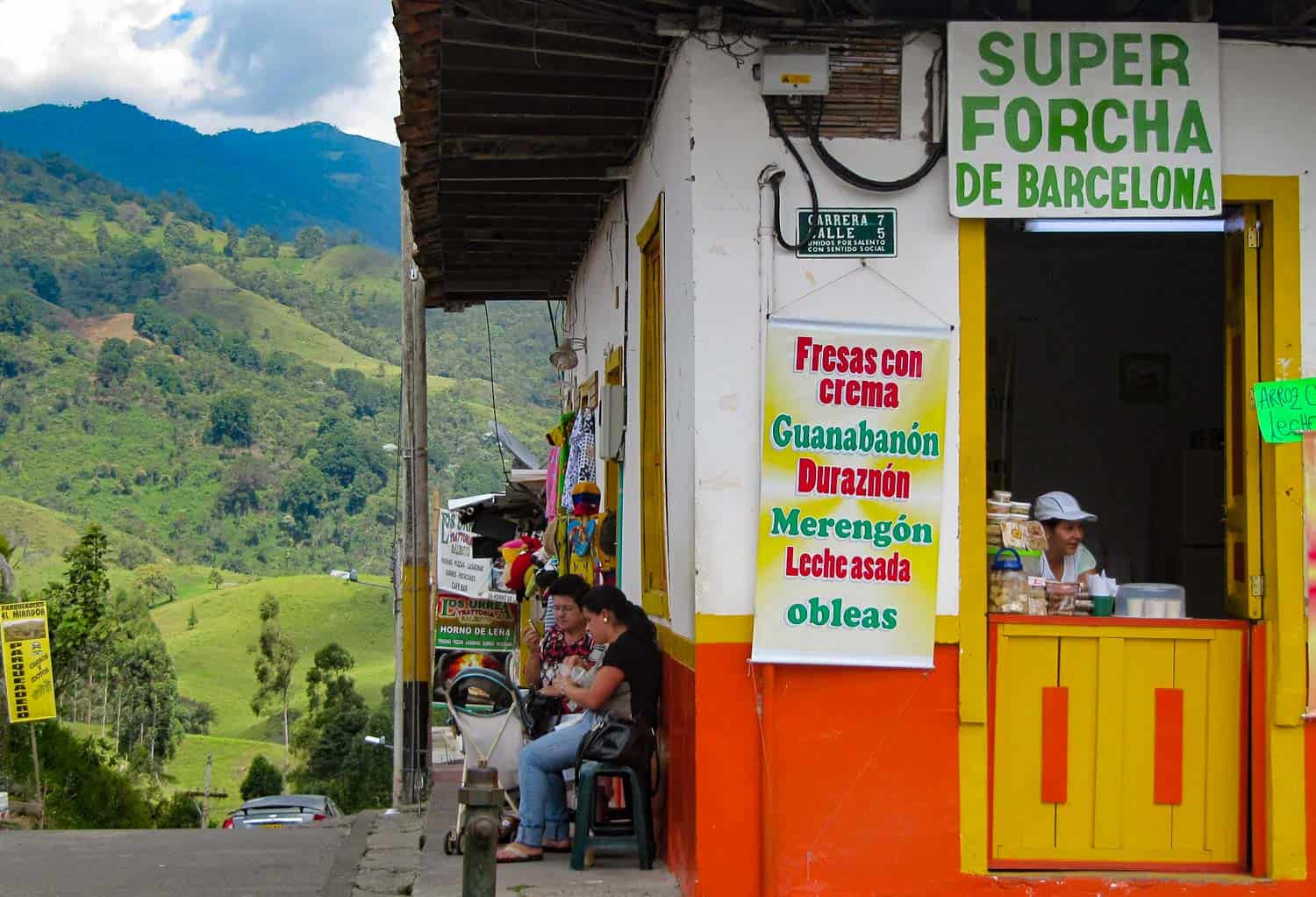
Forcha
This is a homemade punch made in an oak barrel that is very common in Quindio.
So you’ll definitely need to go to small shops or someone’s home to find this.
It is made with aguapanela, flour and some spices and some people compare it to a sweet beer with a very low alcohol.
A foamy fermented drink, if you’re having an upset stomach it is full of good yeast and bacteria to settle things.
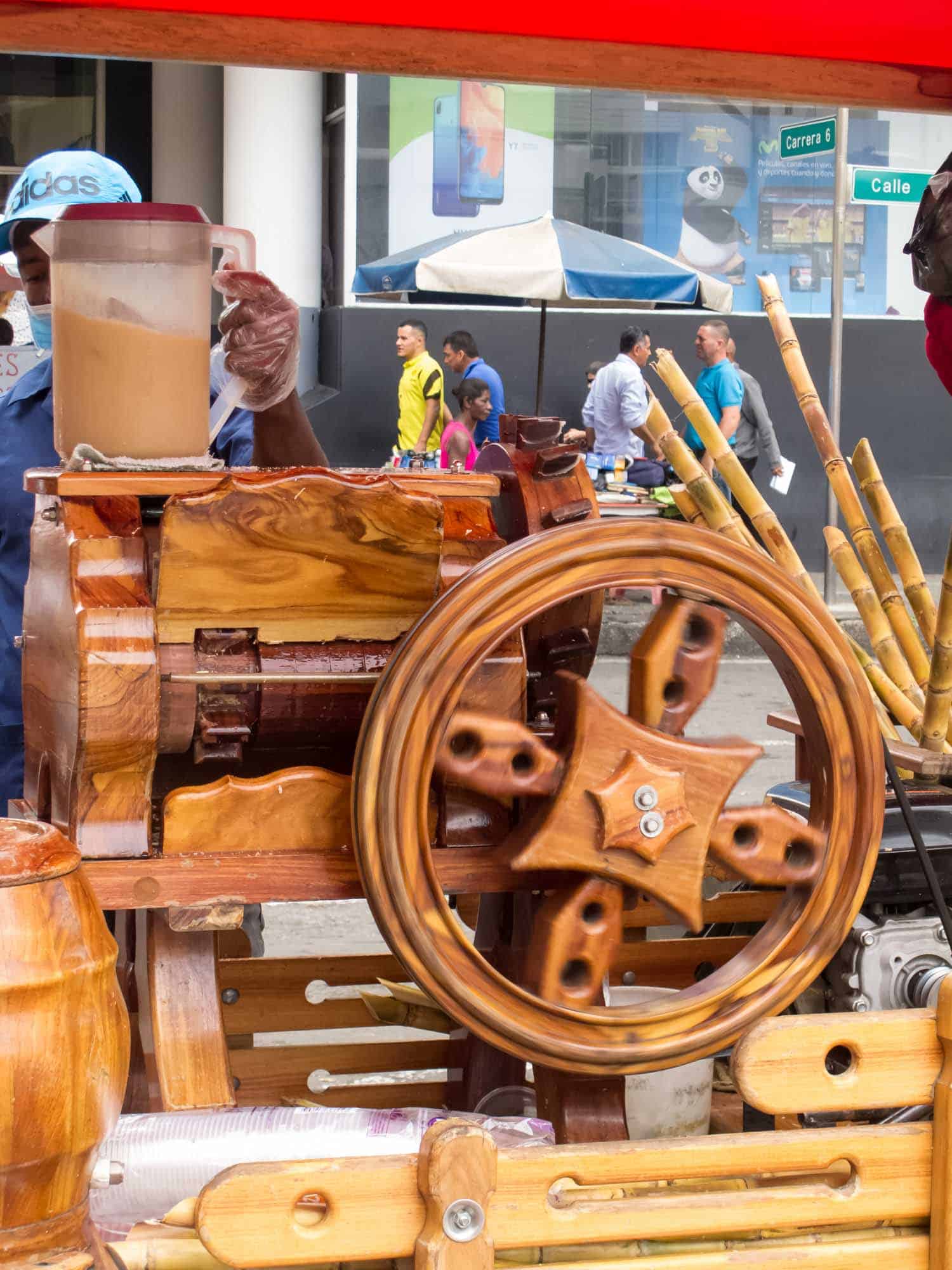
Guarapo
Sugar cane juice! This is common throughout Latin America, and especially common in places like Cuba and Colombia where there is so much sugar cane.
There are lots of guarapo street vendors set up with the trapiche press to make this Colombian drink right in front of you.
Some will also ask if you’d like a bit of lime with it to cut the sugary taste, I think it’s a great addition.
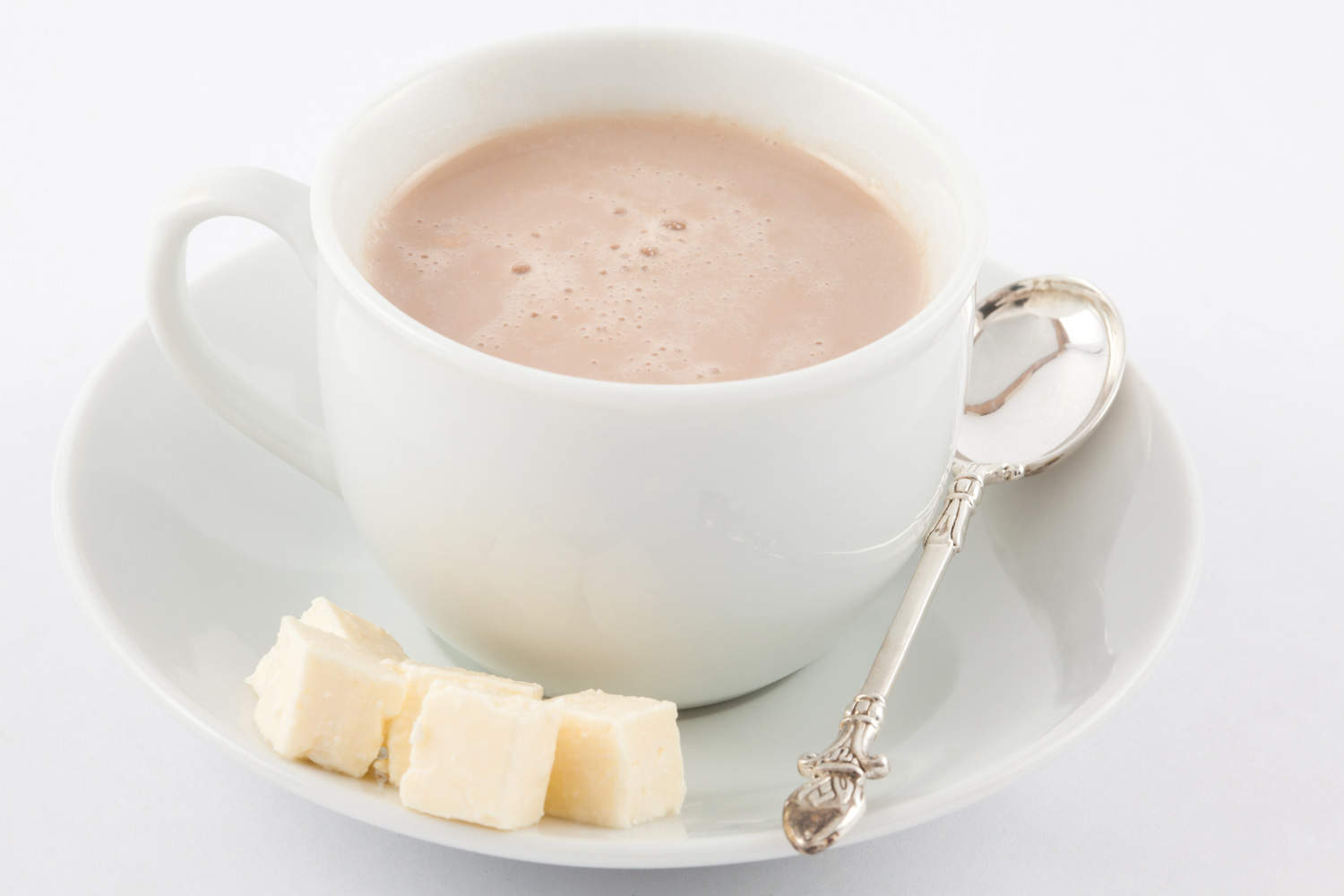
Hot Chocolate
One of the most underrated drinks in Colombia, hot chocolate isn’t just for people who don’t drink coffee.
Colombia grows incredible, high quality cacao and there are a number of great chocolate producers in the country. Hot chocolate is served many ways, it can be with milk, coconut milk or water.
Various spices like cinnamon, clove and orange are also used .
One of the most surprising Colombian drinks is chocolate santafereño.
You’ll find this in Bogota and it’s sometimes it’s also called chocolate caliente or chocolate completo but it is absolutely a must-try experience in Colombia.
This is no ordinary breakfast the hot chocolate is served with a bit of salty cheese called queso campesino or queso fresco.
This isn’t meant to go on the accompanying bread. Instead drop that cheese into your hot chocolate!
Yes into your drink!
Let it wait a bit and then use a spoon to get the melty goodness.
I know it may sound strange but salty cheese with chocolate is a fantastic combination.
It’s also a very filling Colombian breakfast.
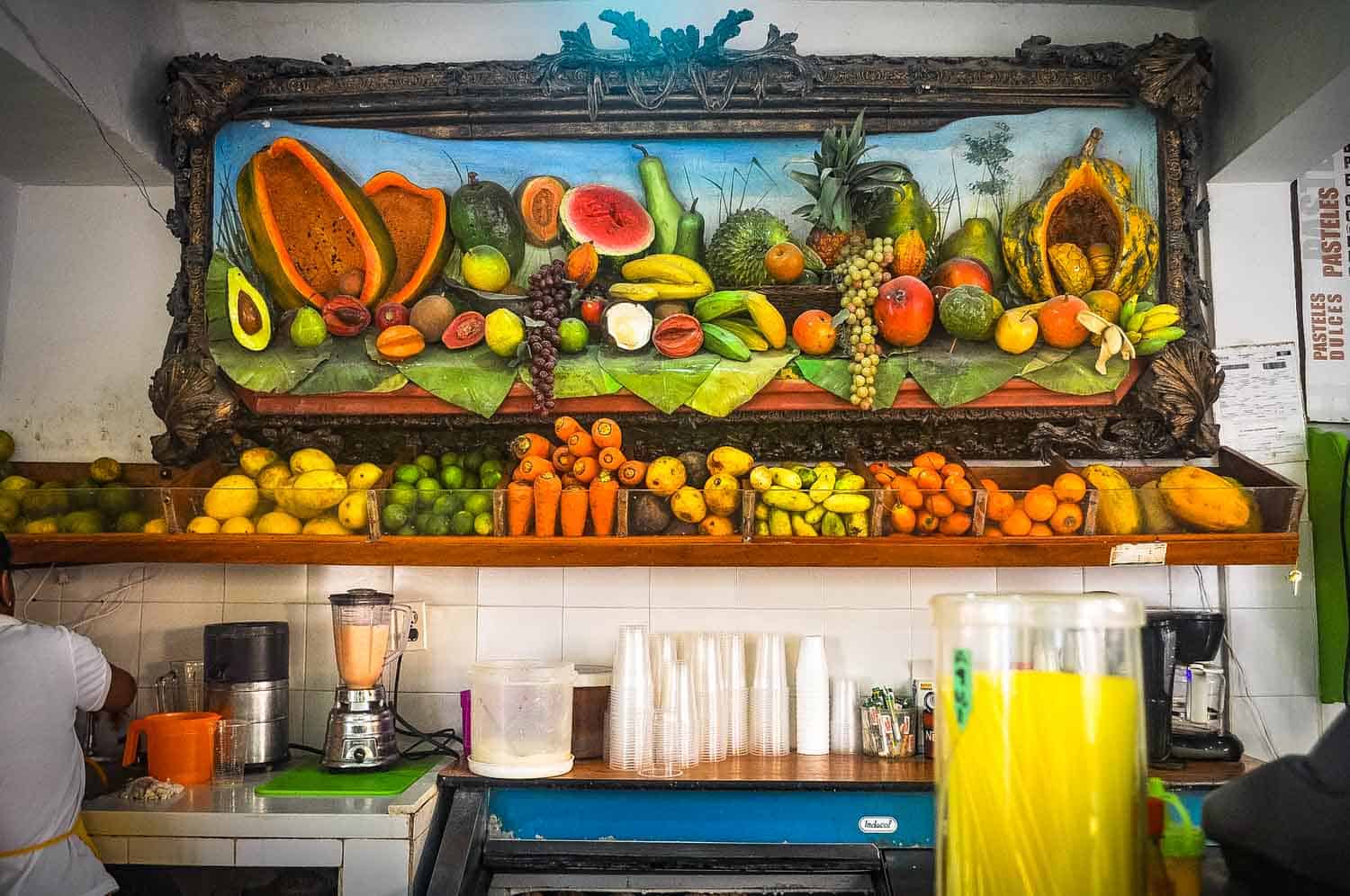
Jugo or Fruit Juices
In North America and Europe we are SUCKERS! We pay $7-10 for freshly squeezed organic juices when Colombians have been doing it for centuries!
I will admit traditional Colombian food isn’t the most dynamic. It’s similar to Cuban food and is heavy on sustenance.
So potatoes, corn, yuca feature prominently as people, mostly slaves, were out in sugar cane fields.
But you CANNOT beat Colombian juice.
Go to a market and you will be overwhelmed by choice. You can go with popular jugo de tamarindo (tamarind juice) or maybe you want the more exotic lulo, guanabana (soursop) or chontaduro (peach palm).
What if you want some vegetable juice, no problem! You can get fruit juice in Colombia to order. Just tell them what you want and you’ll get it!
But what if you have no idea what you should get? Don’t worry there’s usually a long list of options of singular juices or mixes. Have it with water or milk for a smoothie.
If I could put exclamation points on every sentence I would because I’m such a fan of jugo in Colombia. For only a couple dollars you can . try exotic fruit juices you’d never get at home.
I had a Colombian fruit drink or vegetable juice EVERY SINGLE DAY and I miss it SO much.
Kumis
One of the typical Colombian drinks that is losing it’s tradition. It’s not that you can no longer find it. Rather it is more often mass manufactured rather than made at home.
After all why would you make it when it’s cheaper to buy it.
But it’s absolutely worth trying. Almost a sour yogurt drink, it’s cow milk fermented with sugar and lime juice.
It’s somewhat similar to an Indian lassi but not quite.
You can also find this drink in Mongolia where it’s sometimes alcoholic.
However kumis is a turkic word not Mongolian so no one really knows it’s origins or when someone in history brought it to Colombia.
Limonada de Coco
Such an underrated drink in Colombia. It’s like a coconut lemonade, except it’s made with lime.
This frothy drink is from the coast and common it Cartagena.
But it’s so delicious you’ll often find it in Bogota and Medellin as well, because who doesn’t want a drink that tastes like keylime pie?
It can be served as a frozen slushy style drink or on the rocks. It’s non-alcoholic but it is also excellent with a bit of white rum in it.
Lulada
Another Colombian cocktail that uses it’s delicious fruit. You’ll most often find this on the Colombian coast.
It uses lulo fruit mixed with lime juice, sugar, ice and vodka or a Colombian alcohol.
The texture is more like a smoothie as the lulo isn’t blended but mashed.
Masato de Arroz
Colombians love fermented drinks and this is another one! Masato is a creamy drink most often made with rice, water, cloves and cinnamon.
It’s most common in Eastern Colombia but it’s also found throughout South America. It’s also possible to find masato made with yuca or pineapple instead of rice.
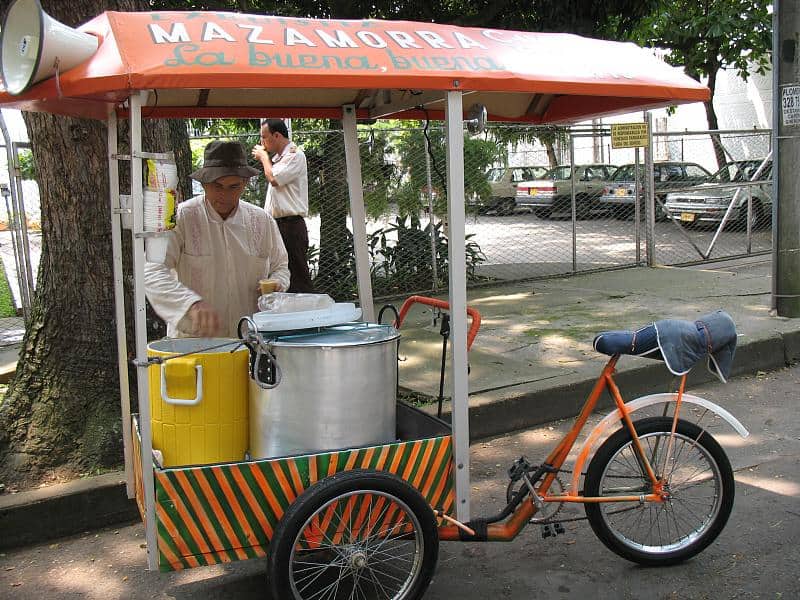
Mazamorra
With “maza” included in its name you know this is going to be a maize or corn based Colombian drink.
You can find mazamorra throughout Latin America as different traditional dishes. In fact this corn drink first started out as a corn stew and evolved over time.
Today, it’s commonly served by vendors with loud speakers promoting they have mazamorra. It is a simple drink of milk infused with corn. There are also pieces of corn in it.
If the idea of corn chunks makes you want to hurl then ask for claro de mazamorra. This is basically the liquid without the chunks of corn but still all the great flavour.
Guatemalan Drinks
Refajo
A very common Colombian cocktail that is best described as a beer shandy or radler.
Refajo is made with beer and Colombiana soft drink, which is similar to a cream soda, technically called soda champagne.
This is a very common drink at barbecues and long lunches.
The drinking age in Colombia is technically 18. So refajo is good for family events as well as it has lower alcohol content.
Although it’s common to also add a few shots of aguardiente or other Colombian liquor.
Rum
You can’t visit a country known for it’s sugar cane without trying some of the local rum. It’s more commonly found on the coast where locals prefer it over aguardiente.
Like aguardiente, it’s common to order a bottle for the table and drink it straight, on ice or with a lime.
If you don’t like it straight there are plenty of Colombian cocktails with rum.
It makes for a fantastic souvenir or gift to take home as you can buy aged rum for a good price.
Sabajón
One of the things I love about discovering food and drink around the world is it’s often so similar.
Our cultures are not as different as we think.
The same is true with sabajón. It is the Colombian version of eggnog, or crema de vie in Cuba.
Instead of rum or brandy, the spirit of choice is aguardiente.
It is very common for families to make a big batch of this during Christmas in Colombia. You never know when friends or family will drop in.
Viche or Biche
Similar to chicha, viche is officially an illegal drink although the law is never enforced.
Part of the Afro-Colombian culture on the Pacific Coast, particularly in the city of Cali.
It is known as a healing drink.
Women, who are called sacadoras, make this drink to cure anything and everything. Need to increase your fertility? Drink viche. Have a stomach ache? Viche will fix it.
If you want to try it ask around for a vichera which is a casual spot to drink viche and listen to music.
What drinks in Colombia did I miss? Let me know in the comments below!
Pin it: Traditional Colombian Drinks
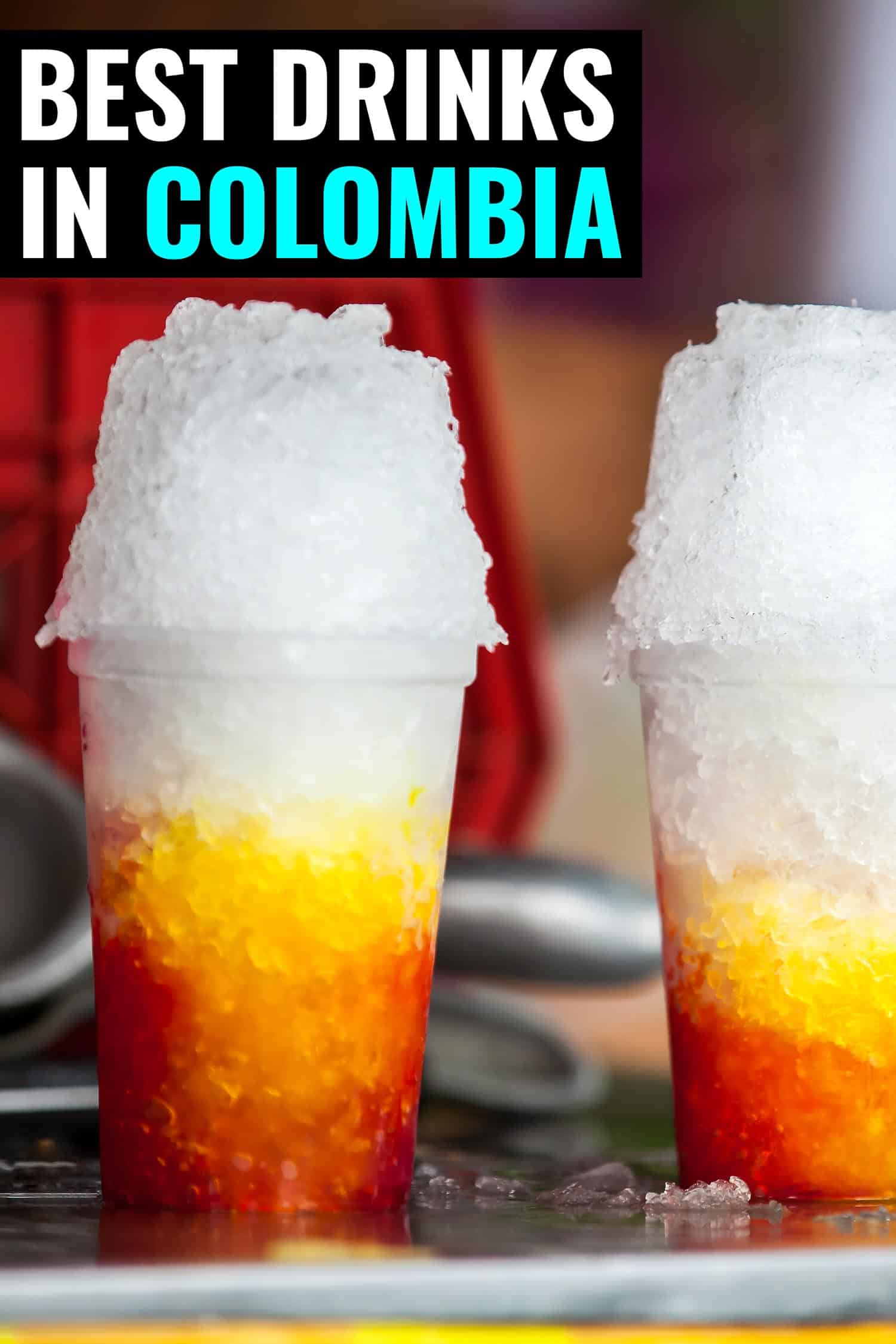
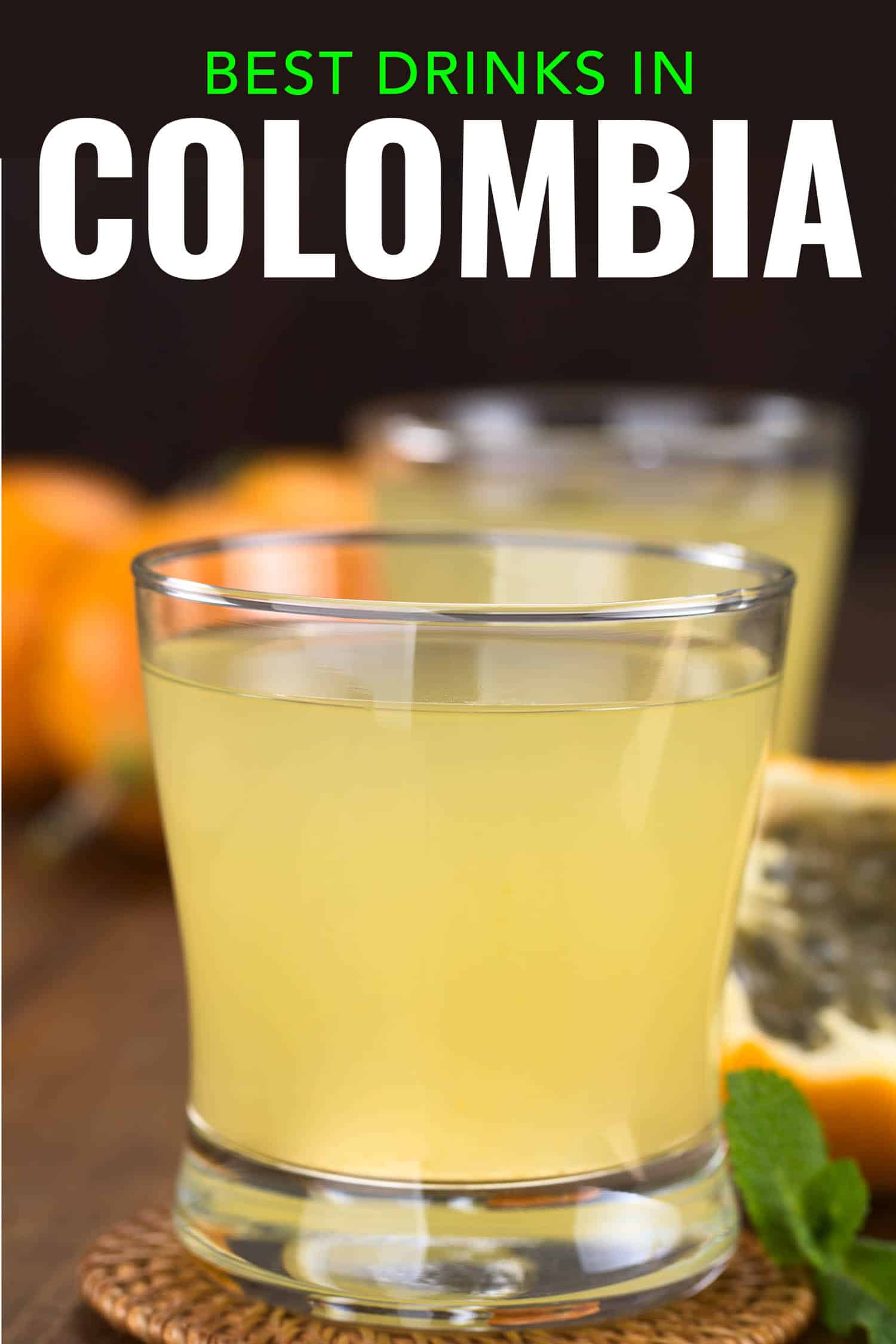
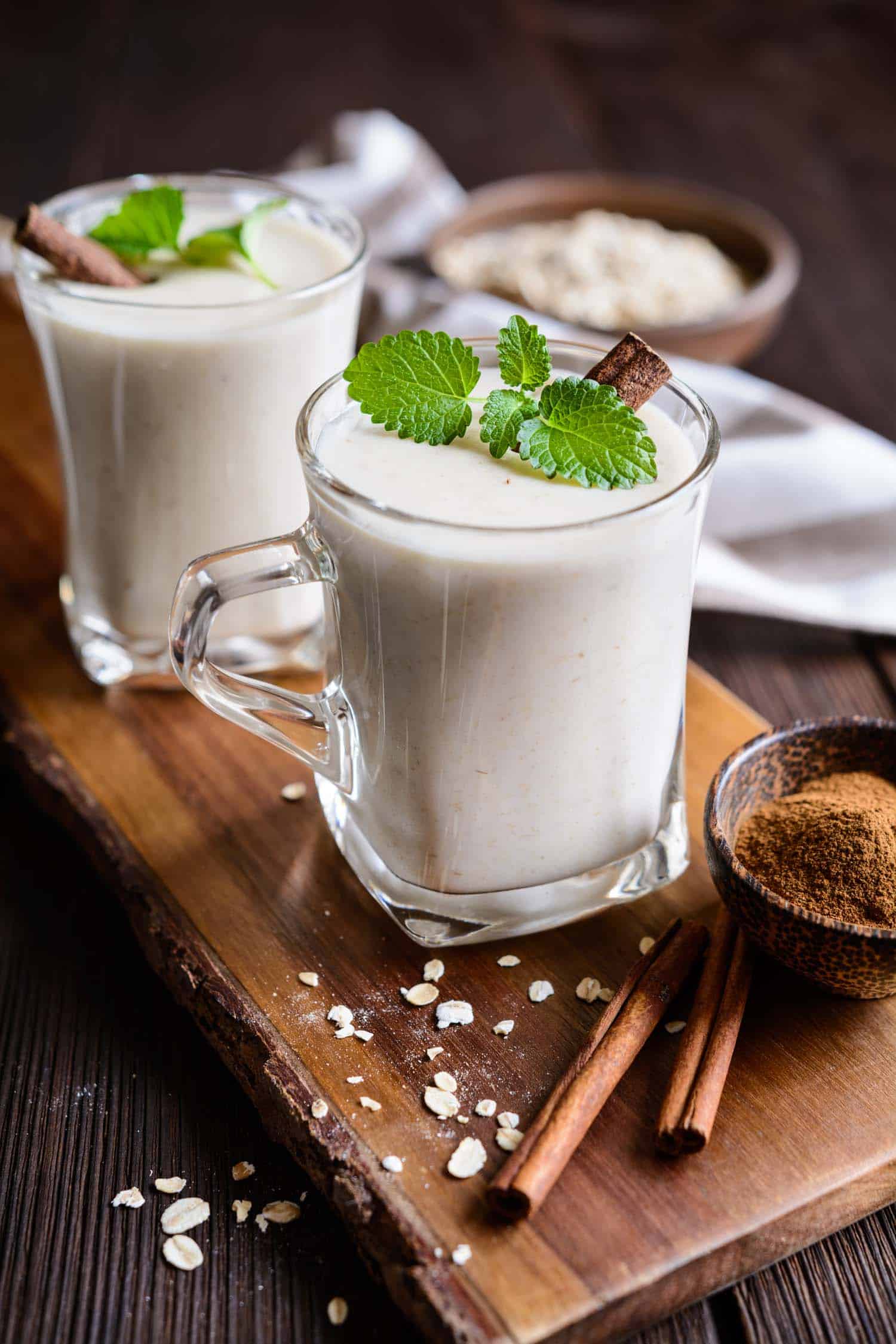


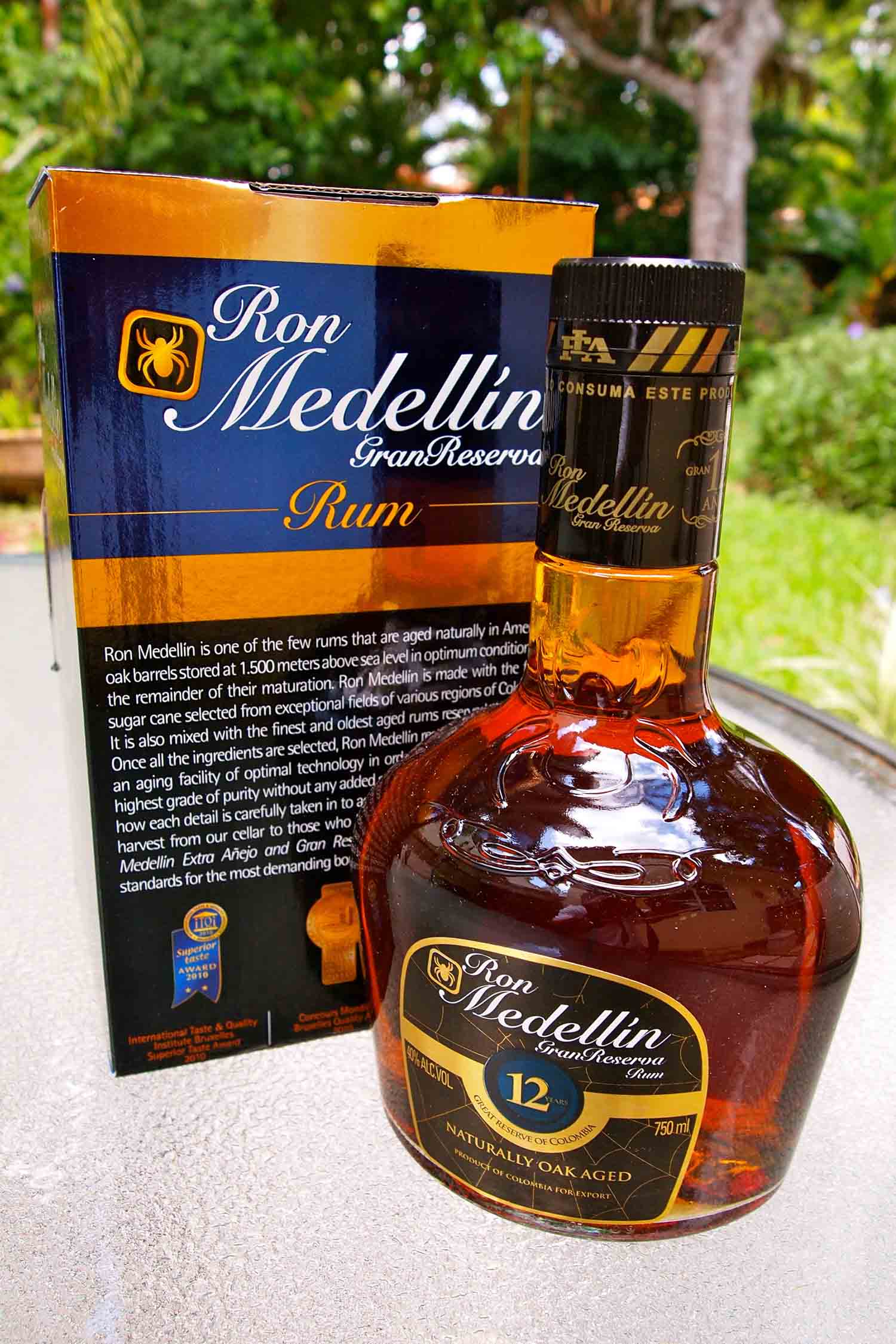
I am starting to plan a trip to Colombia for Dec 2020 with my kids. Hopefully Covid doesn’t ruin it. Was wondering if you could recommend any good travel planning apps? I found one but any others you know of would also be super helpful because I am struggling to plan all the logistics for this trip. Thanks for your guide. It is super useful!
So happy you found this helpful, I have lots of other Colombia content
As for apps I’m not sure I can really help. I do use hashtags on Instagram to find content in a country and network with local content creators but overall I prefer to read blogs or watch videos over apps.
Good morning, you should visit termales in Santa Rosa de cabal I think you will love it. I am colombian whe when I visit my hometown I always have to go to termales and Salento
Oh I would LOVE to visit there, maybe later this year.
It will nice if you can Google it and you’ll see how nice it is. I think you will love it. Please try colombian empanadas and Lulo juice. 🤭